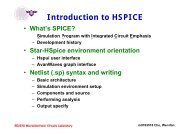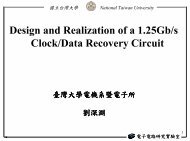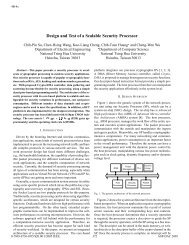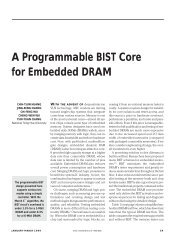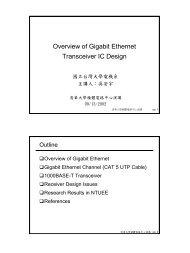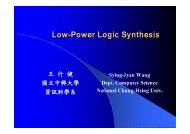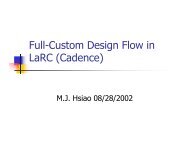A robust feedforward compensation scheme for multistage ...
A robust feedforward compensation scheme for multistage ...
A robust feedforward compensation scheme for multistage ...
You also want an ePaper? Increase the reach of your titles
YUMPU automatically turns print PDFs into web optimized ePapers that Google loves.
242 IEEE JOURNAL OF SOLID-STATE CIRCUITS, VOL. 38, NO. 2, FEBRUARY 2003<br />
Fig. 13.<br />
Measured pulse response <strong>for</strong> large input signal.<br />
Fig. 11. Experimental results <strong>for</strong> the single-ended amplifier. Input step (falling<br />
edge) signal and amplifier response.<br />
TABLE II<br />
POST-LAYOUT SIMULATION AND EXPERIMENTAL RESULTS<br />
WITH LOAD CAPACITOR OF 12 pF<br />
*Due to noise limitations, 0.1% settling time was difficult to measure properly.<br />
Fig. 12. Post-layout simulation results <strong>for</strong> the capacitive amplifier. Pulse<br />
response with a real input signal, including all parasitic capacitors. 1% settling<br />
time is around 14 ns.<br />
Fig. 1 <strong>for</strong> the identification of the capacitors) are shown in Fig. 9.<br />
The values used <strong>for</strong> the capacitors are 0.25, 0.5, 1, 3, 7, and<br />
10 pF. The amplifier’s output represents the typical exponential<br />
behavior of an underdamped system and the phase margin is always<br />
greater than 45 . The 1% settling time is 2.4 and 8 ns <strong>for</strong><br />
capacitors of 0.25 and 10 pF, respectively, when the input step<br />
had a fall time of 100 ps. The feedback and loop gain factors<br />
are reduced if the parasitic capacitors are comparable with the<br />
main capacitors, and the parasitic poles and the RHP zero cannot<br />
be neglected because they are comparable with . These poles<br />
and zeros introduce negative excess phase, reducing the phase<br />
margin. A small overshoot appears in the pulse response of the<br />
amplifier <strong>for</strong> small capacitors of less than 3 pF, which can be observed<br />
in Fig. 9. Also, the effects of the drain–gate capacitor of<br />
transistor M3 are evident in these simulations. increases<br />
the effective feedback capacitor and this effect can be avoided<br />
if cascode amplifier is used in the <strong>feed<strong>for</strong>ward</strong> stage.<br />
The single-ended amplifier was fabricated in the AMI<br />
0.5- m technology through the MOSIS Educational program.<br />
The chip microphotograph is shown in Fig. 10. The active area<br />
<strong>for</strong> the amplifier is around 0.16 mm . An inverting capacitive<br />
amplifier, similar to the one shown in Fig. 1, was used <strong>for</strong><br />
measuring the OTA pulse response. For the test setup, external<br />
capacitors of 5 pF were employed and the load capacitance<br />
was 12 pF (estimated capacitance of measurement equipment<br />
probe capacitance and package bond-pad capacitance). The<br />
pulse response of the fabricated OTA was measured and is<br />
shown in Fig. 11. The 1% settling time <strong>for</strong> an input step of<br />
0.7 V was 15 ns—around 8 ns corresponds to slew-rate phase<br />
and 7 ns are associated with the settling phase limited by the<br />
effective gain–bandwidth product. For these results, the input<br />
edge had a fall time of around 3 ns. It was difficult to obtain<br />
a better step input due to the printed circuit board (PCB),<br />
bond-pad parasitics (DIP-40 package was used), and equipment<br />
loading effects. The output step response has no ringing, which<br />
shows a good phase margin. Post-layout simulation result <strong>for</strong><br />
the amplifier is shown in Fig. 12, with a 3-ns fall-time input<br />
step. The feedback and load capacitors are similar to the ones<br />
indicated in the measurement setup. The 1% settling time is<br />
around 14 ns, which is in con<strong>for</strong>mance with the measured<br />
results. The 0.1% settling time is around 20 ns. Monte Carlo<br />
simulations including 1% transistor mismatches have shown<br />
almost no effect on the speed of the amplifier.<br />
The ac voltage at the noninverting terminal was very small,<br />
even below the noise level. From measurements, the dc gain was<br />
estimated to be around 90 dB. The OTA pulse response <strong>for</strong> large<br />
input signals (up to 1 V) is shown in Fig. 13 and most of the<br />
settling time is due to slew-rate limitation. The input-referred<br />
noise density is around 10.3 nV/Hz . and gain



